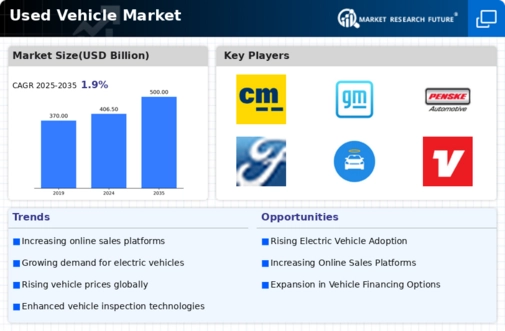Top Industry Leaders in the Used Vehicle Market
*Disclaimer: List of key companies in no particular order
Dynamics of the Used Vehicle Market: A Comprehensive Analysis of Competition, Strategies, and Emerging Trends
The used vehicle market is a thriving and dynamic sector, projected to achieve a value of $2.72 trillion by 2030. This growth is propelled by factors such as affordability concerns, rising fuel prices, and a growing preference for individual mobility. Consequently, the competitive landscape continually evolves, with established players and new entrants fiercely competing for market share.
Key Players:
Franchised Dealers:
These dealerships, often affiliated with major automobile manufacturers, provide certified pre-owned vehicles with warranty coverage and service guarantees. Examples include True Value (Maruti Suzuki), First Choice Wheels (Mahindra), and H-Promise (Hyundai).
Independent Dealers:
These dealerships offer a broader range of used vehicles, typically at lower prices than franchised dealerships. They may provide limited warranties or rely on as-is sales.
Online Platforms:
Disrupting the market, platforms like Cars24, CarDekho, Droom, and Spinny offer transparent pricing, online bidding, and home delivery services. They provide convenience and a wider selection compared to traditional dealerships.
Peer-to-Peer Platforms:
Platforms like OLX and Facebook Marketplace facilitate direct transactions between buyers and sellers. They offer lower prices but less security and transparency compared to other channels.
Rental Car Companies:
These companies often sell their used vehicles after a certain period, offering well-maintained vehicles at competitive prices.
Strategies Adopted:
Differentiation:
Players focus on differentiation through unique value propositions, offering certified pre-owned programs with extended warranties, financing options, and after-sales services.
Digitalization:
Technology plays a crucial role, with online platforms leveraging data analytics and artificial intelligence for personalized recommendations, pricing transparency, and online auctions.
Mobile-first Approach:
With increasing mobile penetration, players develop user-friendly mobile apps for vehicle search, booking test drives, and completing transactions.
Expansion:
Established players expand their geographic reach through new dealerships and partnerships. Online platforms also expand their services to new markets.
Focus on Emerging Segments:
Players recognize the potential of emerging segments like used electric vehicles and subscription-based car ownership, developing customized offerings to cater to these segments.
Factors for Market Share Analysis:
-
Market Share: The percentage of the total market held by a specific player. -
Brand Awareness: Strong brand awareness helps attract customers and build trust. -
Inventory Size and Diversity: Offering a wide range of vehicles across different segments and price points attracts a wider customer base. -
Pricing Strategy: Competitive pricing is essential to attract customers and remain profitable. -
Customer Service and After-sales Support: Excellent customer service builds loyalty and encourages repeat business. -
Digital Presence: A strong online presence is crucial to reach customers and provide a seamless online experience.
New and Emerging Companies:
Subscription-based Car Ownership Platforms:
Platforms like Zoomcar, Revv, and Myles offer flexible and hassle-free access to a car without the need for ownership.
Used Electric Vehicle Specialists:
Companies like EVDirect and Carvana focus on buying, refurbishing, and selling used electric vehicles.
Used Car Financing Startups:
Startups like ZestMoney and Cars24 Finance offer innovative financing solutions to make used car ownership more affordable.
Overall Competitive Scenario:
The used vehicle market is highly competitive, with established players and new entrants vying for market share. The competition intensifies due to technological advancements, changing consumer preferences, and a growing focus on sustainability. To succeed, players need a multi-pronged approach that includes differentiation, digitalization, a mobile-first strategy, expansion into new segments, and strong customer service. Looking ahead, the market is expected to witness further consolidation, with the emergence of a few dominant players. New and emerging companies will continue to disrupt the market by offering innovative solutions and catering to evolving customer needs.
Market Developments and Latest Updates:
Asbury Automotive Group Inc. (ABG)
-
Date: 2023-11-02 -
Development: Asbury Automotive reported a 5.7% increase in used vehicle revenues, attributing this growth to strong demand and strategic acquisitions.
TrueCar, Inc. (TRUE)
-
Date: 2023-11-09 -
Development: TrueCar reported a 12% decline in used vehicle leads, citing a softening used vehicle market and increased competition.
AutoNation, Inc. (AN)
-
Date: 2023-11-07 -
Development: AutoNation reported a 4.3% increase in used vehicle revenues, attributed to a focus on higher-margin used vehicles and improved online marketing efforts.
Mahindra First Choice Wheels Ltd. (MFCWL)
-
Date: 2023-10-27 -
Development: MFCWL reported a 15.7% increase in used vehicle sales volume, driven by strong demand in India and an expanding network of dealerships.

